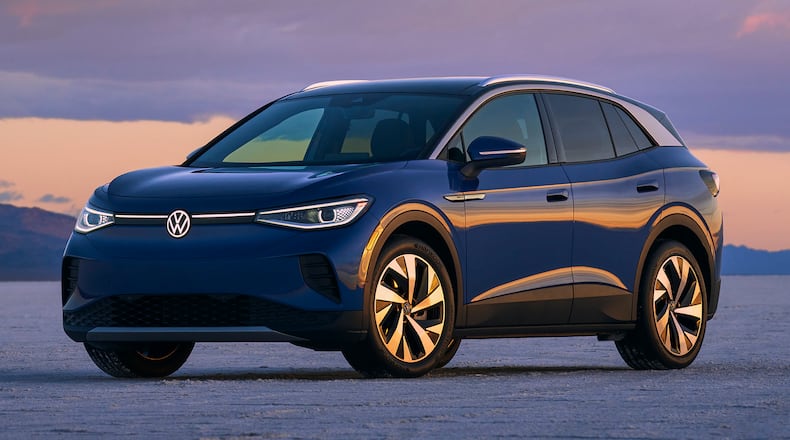Initially offered in Pro and First Edition trims, the two-row, five-seat crossover is built using Volkswagen’s new MEB electric-car platform, and is 4.6 inches shorter, 1.9 inches lower, and 0.5 inches wider than a Volkswagen Tiguan. All models come with a body color roof, black roof rails, and 19-inch aluminum alloy wheels, although you can opt for 20-inch wheels and a black roof with silver roof rails, fixed panoramic glass roof, LED projector headlights with adaptive front lighting, and power-folding side mirrors with puddle lamps.
Given the dull, slab-sided seriousness of Volkswagen SUVs, the ID.4′s gently flowing beltline lends a sensuous softness that counterpoints the vehicle’s sensible shape, while a gray accent visually lowers it, making it very approachable and stylish, with a mainstream charm that’s sure to age well.
Climb inside and you’ll find far more space than its size suggests, with 99.9 cubic feet of passenger volume, and 30.3 cubic feet of cargo space, expanding to 64.2 cubic feet with the seats folded. Head and leg room are superior to the larger Tiguan, despite its shorter length, due to the driveline components being tucked beneath the vehicle, allowing for a flat floor.
The ID.4′s ambience is starkly modern, with none of the visual clutter that’s common in most vehicles. The instrument panel dominated by two flatscreens: a 5.3-inch screen mounted on the steering column that tilts and telescopes with the steering wheel, and a larger 10-inch touchscreen atop the center console — a 12-inch screen is optional and can be fitted with an optional augmented-reality head-up display. In addition, all buttons are capacitive, although there’s no haptic feedback to alert you of activation. Oddly, the transmission switch is mounted next to the instrument cluster and actuates by twisting it forward for drive, and rearward for reverse. A button on its side engages park. It’s very intuitive despite its uncommon design.
And the cabin bristles with thoughtful design. The center console features a forward-sloped surface for wireless charging as well as Apple CarPlay and Android Auto. The console bin’s removable dividers form a cupholder. You’ll find small secondary pockets on the back of the front seatbacks to hold smartphones. And the base of the B-pillars has tie-down points, in case you need to secure cargo. The rear cargo deck’s floor opens to reveal a shallow secondary storage compartment along with another housing the ID.4′s charger and tire patch kit. There is no spare tire, but there a number of grocery bag hooks and USB-C ports.
Standard features include a 10-inch touchscreen, rain-sensing wipers, auto-dimming rearview mirror, dual-zone automatic climate control, keyless entry, a heated steering wheel and a 4G LTE-enabled hotspot for up to four devices.
So far so good; and it only gets better when it comes time to drive. You’ll be surprised that, unlike most crossover SUVs and much like the original Beetle, the ID.4 is rear-wheel drive. It’s rear-mounted 82 kW AC Permanent-Magnet Synchronous Motor and one-speed automatic transmission is mounted to the rear axle, producing 201 horsepower, and 228 pound-feet of torque. Employing rear-wheel drive allowed Volkswagen engineers to use a more powerful engine and eliminate torque steer, a common problem with front-wheel-drive EVs. An all-wheel drive model with more power is arriving later in 2021.
As it stands, the ID.4 is lively and responsive, with the MEB platform providing a solid, planted feel thanks to the placement of the batteries between the axles. It adeptly balances compliance and control, while the absence of an internal combustion engine and road noise makes for a pleasantly peaceful driving experience. And the accelerator and brake pedals are playfully embossed with play and pause symbols. Plus, you’ll be thrilled to find its 33.5-foot turning radius makes quick turnarounds easy.
All ID.4s include forward collision warning with autonomous emergency braking and pedestrian monitoring; blind spot monitor; rear traffic alert; adaptive cruise control; lane keeping assist; emergency assist, dynamic road sign display; park distance control; high beam control; anti-lock braking system and electronic stability control.
The rear-wheel-drive 2021 ID.4 Pro will start at $39,995, before a potential federal tax credit of up to $7,500 that prices it equal to that of a Tiguan SEL.
With its fun-to-drive persona, sublimely good looks, potent powerplant and thoughtful design, the 2021 Volkswagen ID.4 will prove to be a formidable competitor in the compact crossover EV market.
2021 Volkswagen ID.4 First Edition
- Base price: $39,995
- Powertrain: AC Permanent-Magnet Synchronous Motor
- Horsepower/Torque: 201/228
- EPA fuel economy (city/highway): 104/89 MPGe
- Range: 250 mpg
- Charge time (220 volts): 7 hours, 30 minutes
- Length/Width/Height: 180.5/72.9/66.4 inches
- Cargo capacity: 30.3-64.2 cubic feet
Larry Printz is an automotive journalist based in South Florida. Readers may send him email at TheDrivingPrintz@gmail.com.
About the Author
